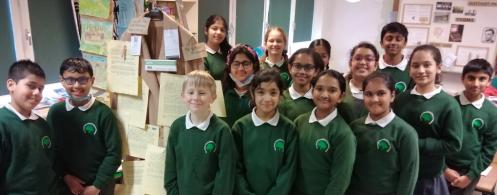
By Marie- Mathilde Wielgus
On the occasion of the 77th anniversary of the liberation of the Auschwitz concentration camp, on this International Day dedicated to the memory of the victims of the Holocaust, the House of European History invited the public to an online screening of the film "Son of Saul" followed up by a discussion, and organised an online workshop for students entitled 'What history do you carry with you?'
During the first session of this workshop, Laurence Bragard, Museum Educator, presented the House of European History and how the museum exposes the Second World War and the memory of the Shoah, to two classes of 11-year-old students from the European School in Alicante and the British International School in Brussels. What can a "house" of European history exhibit? The children were not short of ideas: they expected to see photos, uniforms, treasures of European countries, weapons, trains, tanks. They wanted to hear about civil wars, colonisation, European powers. Since the theme of this workshop is the memory of the Holocaust, the children shared what they knew about it: the deportation and genocide of European Jews, the concentration camps, the gas chambers, the history of separated families, stolen personal items and violated human rights.
A unique object is in the museum's collection that helps to illustrate the workshop: Josef's Coat. Josef Fränkel is the only Holocaust survivor in his family. His daughter, the artist Ritula Fränkel and her husband Nicholas Morris put together a coat with photographs and documents of her father's life, creating this memorial, personal and symbolic work. Based on this model, the children were invited to create a coat decorated with drawings and photos that explain how they cope with difficult times in their lives.
In the second session, the children presented the work that their class has been doing for two weeks: the books they have read, the films they have seen and discussed in class that have supported this exercise. Each class, equipped with a real coat, describes how they structured it. The students of the European School of Alicante drew and hung on the left side of the coat what is dear to them. On the right side were their wishes for the future and on the back, the difficulties related to the pandemic, the distance that separates them from their family. The students from the British International School in Brussels prepared written testimonials, which they stapled together during the session. On the arms were their personal challenges, on the backs the impact that historical conflicts have had on their families in India and Romania. In front they placed the health crisis, the isolation, the wearing of masks that cover not only our faces but also 'our personalities' as one student pointed out.
Mark Scott, a teacher at the European School in Alicante, said that one of the challenges of this exercise was to find the positive side in difficult situations in life and it is by finding what we hold dear, such as family, friends, pets, that it is easier to overcome them. He emphasised the importance of Josef's coat in personalising the Holocaust story to make it more real to children. Beverly Tranter, from the British International School in Brussels, reported that in addition to the educational aspect of this exercise, it allowed children to work on their psychological state and to put into words strong and troubling feelings.
The House of European History thanks the students and their teachers for having participated in this workshop and in the commemoration of this International Day dedicated to the memory of the victims of the Holocaust.

